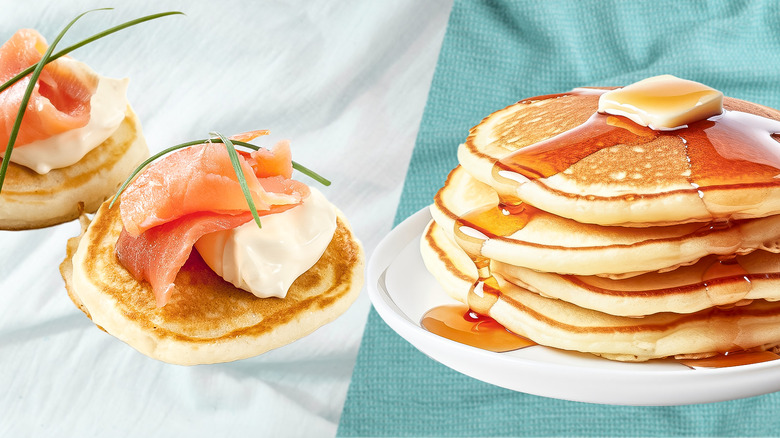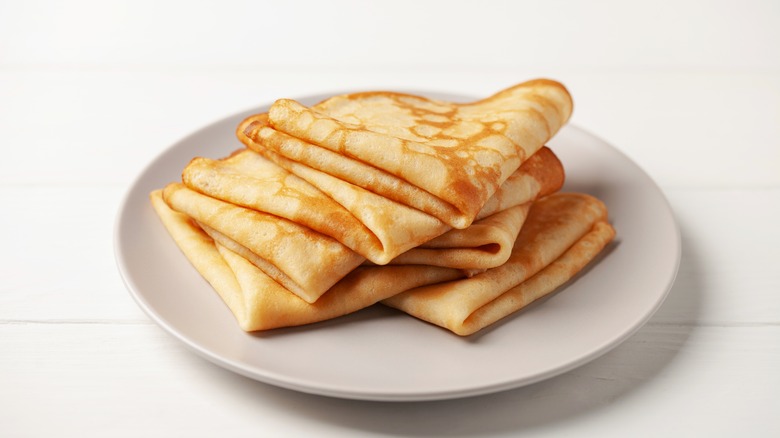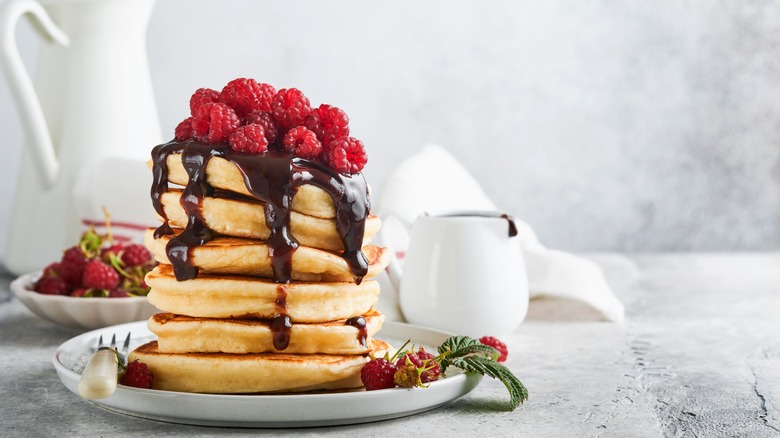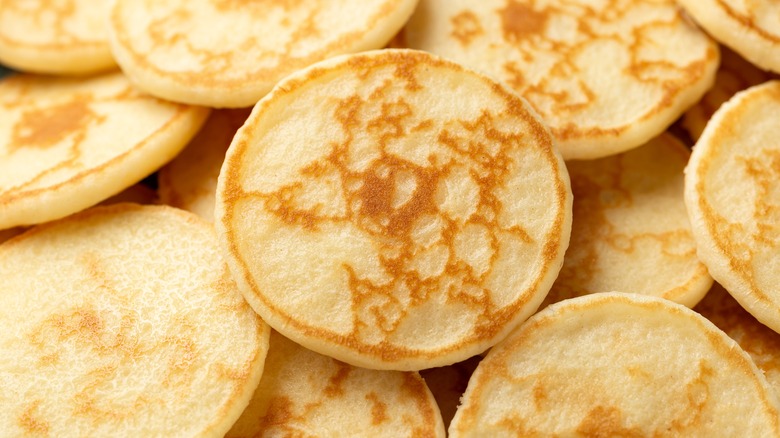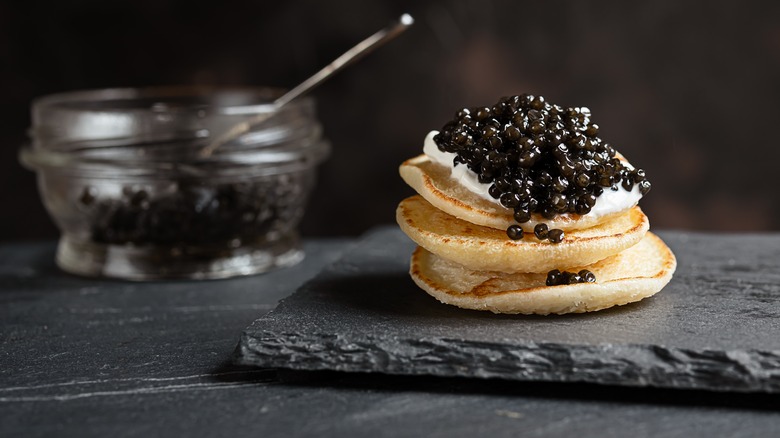What's The Difference Between Russian And American Pancakes?
Few battered creations offer the comforting appeal of pancakes. Crafted with a relatively simple combination of ingredients, and heated on a pan, the food yields a delectably doughy result without the hassles of baking. No surprise pancake-like renditions are found around the world, from Jewish potato latkes to Korean hotteoks and French crepes.
In the U.S., we're most familiar with the classic American pancake, crafted fluffy and sweet for a delicious breakfast. Yet, while dependably delicious, it's just the tip of the iceberg of the pancake world. Take Russian-style pancakes; the expansive country's cuisine packs in a large variety of types.
There's the thin blini, cheese-based syrniki, and thicker olyadi — all delicious but incredibly different creations. As a result, distinguishing between Russian pancakes and the American classic really showcases the expansive breadth of the griddled dish. No matter the variety, there's some culinary inspiration to be found. So let's dive into the details of the two varying pancake cultures.
What are Russian pancakes?
Pancakes are found in Russia with many regional variations that utilize varying flours, taking on different shapes and thicknesses. Buckwheat is one of the most popular bases and is often mixed with other flours. Russian pancakes — a broad term — also include other similarly prepared dishes, like olaydi, which are much thicker, buttermilk-based cakes, originally crafted from oatmeal. Additionally, Russians also make pancake-like creations from farmer's cheese into a dish called syrniki. However, the most popular rendition is a thin-battered cake called blini, which is served by the stack. Such a dish often incorporates yeast into the batter for an airy, yet still thin result.
These pancakes have been enjoyed in the nation's cuisine for centuries and are a prominent cultural dish. Their emergence even predates the arrival of Christianity, with Pagan tradition celebrating their resemblance to the sun. The onset of spring was honored with a weeklong consumption of such cakes. The occasion has now transformed into a Christian-influenced Maslenitsa, which was celebrated the week before Lent. However, blini are consumed year-round; they're one of Russia's most popular foods. They're served with sweet and savory accompaniments and enjoyed at any time of day.
What are American pancakes?
American pancakes refer to a thick, battered creation cooked on a pan. Their distinguishing feature is a leavening agent, which lends a fluffy texture. While there are many deviations in recipes, American pancakes rely on a similar combination of ingredients: eggs, flour, as well as butter, milk, and the leavening component. Most traditional recipes utilize a wheat base, with gluten-free pancakes a newer invention. Fluffiness matched with a thick texture is a key attribute of the dish. As a result, eggs are a key addition, although there are some workaround solutions. Oftentimes, additional ingredients are mixed into the batter to craft creations like blueberry or chocolate chip pancakes. And their maple syrup accompaniment solidifies them as a typically sweet breakfast dish.
Pancakes have long been interlinked with American culture, noted in cookbooks since the nation's emergence. The food was beloved by Thomas Jefferson and consumed as a full meal by many early colonists. Like in Russia, American pancakes were also intertwined with Lent traditions, although their reputation reaches far beyond this tradition.
Russian pancakes vary in size and texture more than American ones
Picture a flapjack: Perhaps a larger creation comes to mind, around four inches or more. A dish in itself, pancakes are dependably thick, instead enriched with additional toppings and sauces. Of course, tasty mini-pancake bites are possible size deviations, but nonetheless, they're seldom used as a component for another dish.
Meanwhile, Russian pancakes take on a much larger array of size and texture. Small blinis — crafted as a vessel for caviar and other small bites — can be less than 1.5 inches in diameter. Russians also craft their blini wider but ultra-thin, similar to crepes in appearance. Such creations are typically rolled with a simple filling.
Other types of Russian pancakes can pack in much thicker textures. Butter-milk-based olyadi takes on a range of fritter-sized creations with a doughy and dense consistency. Of the Eastern European pancake creations, these are the most similar to American-style pancakes, with a similar fluffy appeal. And for an even denser offering, there are also the cheese-based syrniki, which have a soft, but firmer consistency than a pancake.
Russian pancakes are served beyond breakfast
Both dishes offer versatility with toppings, sauces, and fillings, especially the sweeter ones. From fruit to compotes, Nutella, ice cream, and bacon, a range of flavors go well with pancakes. American pancakes' thicker texture also enables adding filling to the interior. Likewise, while substantially thinner, Russia's crepe-like blini are also easily melded with an array of sweet components. Jams and berries are also frequent toppings. And with Russia's penchant for varying dairy products, blini are often rolled around cheese — a popular combination that is distinctly referred to as nalisniki. Even cheese-based syrniki pancakes are often covered with a hefty drizzle of sour cream.
In addition to Russian pancakes' connection to dairy products, they're just as often served with savory accompaniments. Blinis are iconically paired with caviar and smoked fish, especially salmon or herring. And in the meat and poultry department, liver pâté, ground meats, or prepared chicken are common choices, too. The food's light and airy consistency perfectly matches diverse textures, yielding a wonderfully versatile vessel for flavors.
